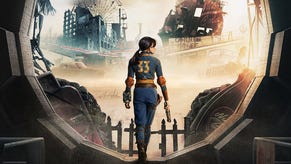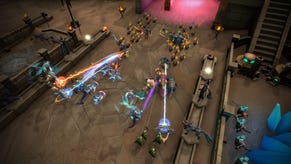How Thumper added VR late in the game
A few clever tricks went a long way
Developing for virtual reality is a very different beast from developing for standard 2D monitors, so much so that people have generally accepted that the best VR games are built from the ground up for VR. However, one of the standout stars of the PlayStation VR launch, the critically acclaimed rhythm game Thumper, was never designed with VR in mind.
Speaking at the Game Developers Conference Monday, Drool co-founder Marc Flury said when he first started working on the game in 2009, it was supposed to be an Xbox 360 title. Obviously, lots of things changed over the game's seven year path to release, including the addition of VR support.
Flury wasn't a big supporter of VR early on. His first experiences with VR were "very negative," roller coaster and skydiving demos on Oculus DK1 that made him very ill. The assumption was that something like Thumper would be a similarly awful experience in VR, but Flury looked a but further into the idea just because he knew there were lots of marketing opportunities in the segment.
He attended a GDC China talk about motion sickness in VR, where he learned that many of the problems people experience were due to changes in acceleration. When the eyes see that you're speeding up or slowing down, but your body doesn't feel the corresponding forces, nausea happens. Flury realized that while the player is travelling fast in Thumper, the travel is generally locked at a constant speed because it's a rhythm game.
Excited about the possibility of bringing the game to VR after all, Drool got a dev kit and found that many of the fundamental issues in converting the game to VR could be addressed with little difficulty. First, the field of view had to be adjusted. On 2D monitors, Thumper had a super-wide field of view of about 150 degrees that helped the space feel deeper and heightened the sense of speed. But VR headsets have limited fields of view, and playing Thumper in PSVR's 100-degree field of view made the game feel slow and unexciting. Flury thought it would be a hard problem to solve, but his co-founder at Drool Brian Gibson had an easy fix. They scaled all of the elements of the track up to be twice as long, and then increased the player to be twice as fast. It sounded insane, Flury said, but it restored the sense of speed from the 2D version of the game.
There was also a question about how big the game world should be relative to the player's head (which doubles as the game camera in VR). At first, they tried making the beetle-like protagonist about 40 times larger than a person, which made it feel really detached and distant. Then they tried making the beetle about the size of the player's head, but found that approach had its own issues.
"This felt like you were flying head first in this hell ride," Flury said. "It was really intense, too intense. It felt like you were being smacked in the face, and it was almost a little nauseating."
They settled on a sweet spot of having the beetle be the equivalent of about 40 cm, which made it feel more like being on a slip-and-slide, a good compromise between intensity and comfort.
One more tweak they made for VR was adjusting the scale of the game's level-ending boss, a monstrous track-swallowing head which Flury referred to as Crackhead. On a 2D monitor, there was only so much room to fit Crackhead on the screen, so they had to limit his size to make him completely visible. But VR has no such restrictions, so they made him four times bigger, towering over the players so they could look up in awe at him.







